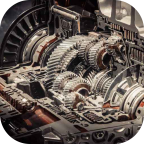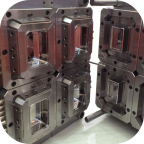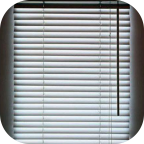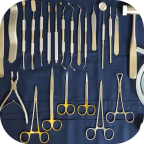Proper Disposal of Used Ultrasonic Cleaning Solution
Browse Volume:90 Classify:Support
When most people look at the cloudy, used fluid sloshing in their ultrasonic cleaner, the instinct is simple: dump it down the drain and move on. After all, it’s just water, right?
Not quite.
That liquid may look harmless, but depending on what you’ve been cleaning—and what solution you used—it could carry everything from heavy metals and oils to biological contaminants and toxic residues. And once it goes down the drain, those substances don’t just disappear. They can harm plumbing, pollute waterways, or violate local waste regulations, especially in commercial or medical environments.
This is where the importance of proper ultrasonic cleaner solution disposal comes in. It’s about protecting more than your pipes—it’s about safety, compliance, and environmental responsibility. While this topic may seem niche, it sits at the intersection of public health, industrial safety, and green practice. Whether you’re a dentist sterilizing tools, a jeweler restoring heirlooms, or a DIYer cleaning car parts in your garage, what you do with your used solution matters.
And that doesn’t mean you have to fear it. With the right information, disposing of ultrasonic cleaner solution becomes straightforward—and even a chance to build more sustainable habits.
What’s Actually in Your Used Ultrasonic Cleaning Solution?
To make smart decisions about disposal, you have to understand what you’re actually dealing with.
At its core, ultrasonic cleaning works by generating microscopic cavitation bubbles in a liquid bath. These bubbles collapse with enough force to dislodge contaminants from even the tiniest cracks and surfaces. But the power of the process lies not just in the sound waves, but in the cleaning solution used—often a water-based formula tailored for specific contaminants.
These solutions fall into several broad categories:
- Neutral detergents – commonly used for general-purpose cleaning (e.g., glasses, surgical tools)
- Enzymatic cleaners – frequently used in medical and dental fields to break down proteins and organic matter
- Alkaline solutions – ideal for removing oils, waxes, greases, and carbon deposits from metal parts
- Acidic solutions – useful for removing rust or mineral buildup
- Solvent-based cleaners – less common in household units but used industrially for degreasing or precision parts
Once cleaning is complete, the liquid isn’t just the original formula anymore. It now contains:
- Dissolved and suspended solids
- Biological matter (e.g., blood proteins, tissue, saliva from dental tools)
- Metal particles or heavy metals (from parts cleaning)
- Petroleum-based oils, greases, and lubricants
- Soap scum, waxes, and adhesives
This chemical and physical cocktail is why used ultrasonic solution is not equivalent to “dirty soap water.” It’s often classifiable as gray water or, in some cases, even hazardous waste.
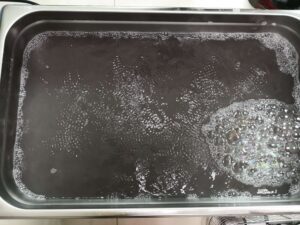
Close-up of an ultrasonic cleaner tank filled with murky solution
Is It Safe to Pour Down the Drain? A Conditional Answer
Here’s the truth most people want a yes-or-no answer to: Can I just pour it down the sink?
Sometimes, yes. Often, no.
Let’s start with the more forgiving case: a water-based, biodegradable detergent with minimal contamination, such as when you clean eyeglasses, jewelry, or plastics. If you’re not using chemicals and the waste doesn’t contain any regulated substances, local wastewater systems in many residential areas can handle light discharge.
But things quickly change when the solution contains:
- Heavy metals like lead, mercury, or cadmium
- Petroleum oils or synthetic lubricants
- Hazardous solvents or surfactants
- Biohazards, including saliva, blood, tissue, or bacteria
- Acidic or high-pH residues that can damage plumbing or violate pH limits on wastewater discharge
In many countries, the law distinguishes between residential disposal (like rinsing a dirty dish) and commercial or industrial waste. What’s allowed at home may be illegal in a dental clinic or automotive shop. That’s why so many organizations require a Safety Data Sheet (SDS) for each cleaning solution used, outlining chemical hazards and disposal requirements.
To add another layer of complexity, regulations vary widely depending on your location:
- In the United States, the EPA, local water authorities, and sometimes state environmental departments govern wastewater disposal.
- In the EU, the European Waste Catalogue (EWC) codes define hazardous vs. non-hazardous waste.
- In Australia and Canada, most local councils have their own household chemical waste drop-off sites.
When in doubt? Contact your local water treatment authority or environmental health office. It’s always better to ask than to assume.
How Professionals Handle Disposal: Industry Best Practices
If you’re wondering how dentists, aerospace engineers, and lab technicians deal with their used ultrasonic solution, the answer is: carefully—and in full compliance with regulations.
Let’s take dental and medical facilities first. These environments handle a wide variety of biological contaminants, from blood to saliva to microscopic tissue fragments. According to the Centers for Disease Control and Prevention (CDC), any cleaning solution that comes into contact with patient-contaminated instruments should be treated as potentially infectious and disposed of daily or between patients. Most of these clinics rely on enzymatic or detergent-based solutions, which, while less chemically aggressive, still carry significant organic load after use.
The CDC recommends that these solutions be discarded in accordance with local biohazard and sewage regulations, which often means sealing them in leak-proof containers and sending them to a medical waste disposal contractor. Pouring them into a sink—even with a sewer connection—is rarely acceptable in clinical settings.
In manufacturing, electronics, and aerospace sectors, ultrasonic cleaning often involves alkaline or acidic solutions, sometimes containing ammonia, EDTA, or chelating agents that can strip oxides or polish metals. These industries typically maintain dedicated chemical waste streams, with clearly labeled containers, logs, and safety inspections. Industrial shops will frequently work with hazardous waste haulers to collect and process used fluids, ensuring compliance with the Resource Conservation and Recovery Act (RCRA) or equivalent international standards like RoHS and REACH.
Then there’s the jewelry and horology world, where ultrasonic cleaners are prized for rejuvenating precious metals and gemstones. While jewelers don’t deal with biohazards, they often clean items coated in polishing compounds, flux residues, or tarnish, which can contain lead, silver, or even trace mercury from antique pieces. Reputable jewelers don’t dump their spent solution down the sink, especially not if it’s visibly cloudy or odorous. Instead, they filter out solids, bottle up the used fluid, and hand it off to certified waste processors—sometimes even extracting precious metals from the sediment.
Across all industries, the trend is the same: professionalism equals accountability. That includes proper labeling, logging, and handling of spent solution as part of the broader environmental compliance system. It’s not just about ticking boxes—it’s about protecting waterways, staying ahead of inspections, and preserving community trust.
Safe Home-Based Disposal Practices (for Light-Use Cleaners)
But what if you’re just a hobbyist, a home mechanic, or someone who uses an ultrasonic cleaner to clean personal items like glasses, retainers, or small parts? Do you need to follow the same stringent rules?
Not necessarily—but some caution still applies.
For home users, the most important thing is to identify what’s in your cleaning solution and what’s been cleaned with it. If the solution is neutral or lightly alkaline, biodegradable, and used to clean non-toxic, non-oily items, you may be able to dispose of it safely via your household wastewater system.
Still, it’s wise to follow these best practices:
- Let solids settle. After cleaning, allow the solution to sit undisturbed. Solid debris (like polish grit or metal flakes) will settle at the bottom. You can pour off the top liquid and capture the residue in a disposable container.
- Use a filter. Pour the solution through a fine mesh or coffee filter into a second container. This traps visible debris, which can then be double-bagged and placed in household trash (if not hazardous).
- Dilute before disposal. If allowed, dilute the solution with water at a 1:3 or higher ratio before pouring it down the drain, and always flush with copious clean water.
- Never mix chemicals. If you’ve used different cleaning formulas, don’t combine them in one disposal batch. Some chemical agents can react dangerously—even if they seem mild alone.
- Avoid disposal on soil or in outdoor drains. Garden hoses, storm drains, and backyard soil are never acceptable outlets. These lead directly to the environment without filtration.
And again, review your solution’s SDS—even many household-safe ultrasonic cleaners include a link or QR code to view it online. It will tell you everything from pH levels to environmental risks to disposal directions.
Hobbyist tip? Keep a small disposal journal or sticky label system if you frequently clean different types of objects. This will save you the headache of guessing whether your fluid qualifies as “safe” when it comes time to dump it.
Partnering with Disposal Services and Waste Haulers
For businesses, clinics, and even serious hobbyists who use ultrasonic cleaners frequently—or with harsher chemicals—partnering with a licensed waste hauler may be the most responsible and legally sound route for disposal.
These services aren’t just for large industrial operations. In fact, many waste haulers now offer scaled plans for small businesses, labs, and workshops. Depending on your volume and frequency of use, you can schedule monthly pickups, use drop-off locations, or rent storage drums that get swapped out when full.
Here’s what you gain when you outsource:
- Regulatory compliance: Licensed waste handlers are trained in EPA, OSHA, RCRA, and local waste disposal laws. This removes the burden of interpreting technical regulations on your own.
- Safety documentation: Most companies provide manifest forms, chain-of-custody records, and disposal certificates, which may be required for audits or insurance.
- Proper equipment: Waste contractors supply you with clearly marked drums, spill-proof lids, and sometimes even funnels or liners for safe transfer of liquid waste.
- Peace of mind: You’re not guessing about pH limits, heavy metal content, or how to neutralize solvents before disposal. You’re hiring experts to do it right.
One point of concern for some users is cost. Waste removal can range from $50 to several hundred dollars per collection depending on location, type of waste, and frequency. But consider the cost of a fine, a PR issue, or a local environmental complaint—especially for commercial operations. In many cases, partnering with a hauler is not just a safety decision but also a smart business one.
For small-scale users, check your local municipal waste program. Some cities and counties have household hazardous waste (HHW) collection events or drop-off sites where you can take used ultrasonic cleaner fluids along with paint, solvents, batteries, and other chemicals.
Going Greener: How to Minimize Disposal Waste
While safe disposal is essential, there’s another side to the equation: reducing how much solution you need to dispose of in the first place.
A few proactive changes can drastically reduce the frequency of fluid replacement and, in turn, lessen the volume of chemical waste you generate.
1. Reuse Solution Intelligently
Many ultrasonic solutions—especially those without heavy contamination—can be reused for multiple cycles. You can increase reuse safely by:
- Filtering the fluid after each use
- Using a two-tank system (first bath for initial grime, second for finishing)
- Monitoring pH and clarity to know when degradation occurs
2. Choose Biodegradable, Eco-Certified Fluids
Many cleaning solution brands now offer green-certified or plant-based alternatives. These break down more easily in water systems, contain fewer surfactants, and are often septic-safe. Brands like Branson, Elma, and L&R all offer lines marketed as environmentally friendly.
3. Invest in Pre-Cleaning Tools
If you remove loose debris manually before ultrasonic cleaning—using brushes, wipes, or hot water—you dramatically extend the usable life of your solution. Less soil means slower saturation.
4. Upgrade to Machines with Filtration or Drain Ports
High-end ultrasonic cleaners (especially industrial units) may include filtration systems, oil separators, or multi-stage chambers to keep the solution cleaner for longer. Some systems allow continuous filtration during operation, removing debris in real time.
These upgrades pay for themselves over time in the form of less chemical use, fewer disposal needs, and lower environmental impact.
And beyond the ecological benefits, they help keep your ultrasonic cleaner performing at peak efficiency—because dirty solution not only cleans less effectively, but also shortens the lifespan of the unit’s transducers and heaters.
Practical Scenarios: Real-Life Disposal Questions Answered
Understanding the rules is one thing—but applying them in the real world is another. Let’s walk through some common disposal scenarios and how to handle them properly.
“I cleaned my eyeglasses with a mild solution. Can I pour it down the sink?”
Most likely, yes—if you used a neutral or mildly alkaline detergent designed for household use, and no heavy contaminants were present. Still, use a strainer or coffee filter to remove any particles, and flush with clean water afterward.
“I run a dental clinic and use enzymatic ultrasonic solutions for instrument cleaning.”
You’re in the realm of biohazardous waste, even if the liquid looks clear. According to CDC guidelines, this solution should be collected in leak-proof containers and treated as regulated medical waste. Never pour it into the sink. Partner with a licensed medical waste disposal company.
“I cleaned car parts in an ultrasonic tank using an alkaline degreaser.”
Your solution now contains petroleum byproducts, possibly heavy metals like lead or cadmium, and likely violates local wastewater limits. In this case, collect the used fluid in a chemical waste container and contact your local hazardous waste disposal center or certified hauler.
“I clean jewelry with an ammonia-based solution—what should I do with it?”
Ammonia can be a concern in high concentrations, especially when combined with other solvents. If your solution is used lightly and diluted, you may be able to dispose of it in small quantities down the drain with a lot of water—but always consult the SDS for that specific solution, as some brands combine ammonia with more aggressive chemicals.
“I only use ultrasonic cleaning a few times a year. What should I do with old solution?”
If the solution is safe to drain (biodegradable, neutral, lightly contaminated), follow the earlier home-based disposal tips. Otherwise, store it in a tightly sealed plastic container, label it, and bring it to your community’s next household hazardous waste drop-off event. You can usually find these dates on your city’s waste management website.
The Bottom Line: Responsibility Over Routine
When it comes to ultrasonic cleaner solution, disposal is not just the final step—it’s a continuation of the cleaning process. Just as you wouldn’t reuse filthy solution on delicate parts, you shouldn’t treat disposal as an afterthought.
What goes into your ultrasonic bath doesn’t just vanish when you drain it. It enters pipes, water systems, and ecosystems. A careless pour can turn into a chemical leak or even a compliance violation. But a conscious, informed action? That’s part of being a responsible user—whether you’re a surgeon, a watchmaker, or a weekend hobbyist restoring vintage carburetors.
Fortunately, safe disposal doesn’t require heroics—just good habits. Know what’s in your solution. Use biodegradable fluids when possible. Read the SDS. And when in doubt? Store, label, and ask your local waste authority or supplier.
A cleaner tool shouldn’t come at the cost of a dirtier planet.
 Granbo Ultrasonic
Granbo Ultrasonic

